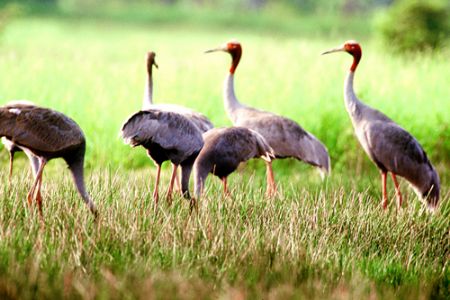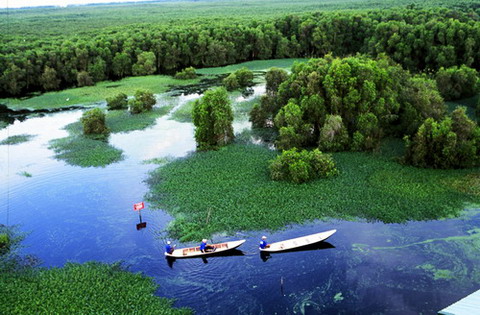Tram
Chim National Park

Alternative site name(s)
Dong Thap Muoi, Tram Chim Tam Nong
Province(s)
Dong Thap
Area
7,588 ha
Coordinates
10o40' – 10o47'N, 105o26' – 105o36'E
Distance(s)
From Ho Chi Minh City
Eco-tours
Bird watching. Contact
us for more information
Topography and hydrology
Tram Chim National Park supports one of
the last remnants of the Plain of Reeds wetland ecosystem,
which previously covered some 700,000 ha of Dong Thap, Long
An and Tien Giang provinces. The national park is located
19 km to the east of the Mekong River, at an elevation of
about 1 m. The topography of the national park is flat,
and slopes slightly to the east. In the past, several natural
streams and rivers flowed from west to east, distributing
water from the Mekong River to the Plain of Reeds. Now these
streams and rivers have been replaced by a system of canals,
some of which flow through the national park.
Prior to canalization, the Plain of Reeds was seasonally
flooded with standing water for continuous periods of up
to seven months per year. Since canalization, floodwaters
drain more rapidly, and the national park is flooded for
less than six months per year. Water levels in the canals
begin to rise in June, at the beginning of the rainy season.
Between September and December, the national park is inundated
to a depth of 2 to 4 m, with a peak in October.
Since the mid-1980s, 53 km of dykes fitted with sluices
have been constructed around the national park, with the
aim of impounding floodwater for longer, and reducing the
lowering of the water table during the dry season. The national
park is fragmented by canals into five management zones;
the water level of each can be managed separately
Biodiversity values
The vegetation of Tram Chim National Park
comprises a mixture of seasonally inundated grassland, regenerating
Melaleuca forest and open swamp. Melaleuca is distributed
throughout the national park, both in plantations and in
scattered patches in areas of grassland or open swamp. There
are five widespread grassland communities at Tram
Chim, of which the community dominated by Eleocharis
dulcis and wild rice Oryza rufipogon is of the highest conservation
significance. Tram Chim is one of the few places in the
Plain of Reeds where this community is likely to survive
to any extent, and, therefore, one of the most important
sites for the conservation of wild rice in Vietnam. The
other grassland communities are dominated by Eleocharis
ochrostachys, Panicum repens, Ischaemum rugosum and Vossia
cuspidata. Another vegetation type found at Tram
Chim is lotus swamp, which is dominated by lotus
Nelumbo nucifera, along with Nymphaea nouchali, N. pubescens
and N. tetragona.
The site supports significant numbers of waterbirds, particularly
during the winter months. Of particular importance is the
non-breeding population of the eastern subspecies of Sarus
Crane Grus antigone sharpii, which regularly spends the
dry season at the national park. Between 1989 and 1999,
the maximum dry-season count of Sarus Cranes at Tram
Chim ranged from 187 to 814 individuals, with a
mean of 496.
In addition to Sarus Crane, the globally endangered Bengal
Florican Houbaropsis bengalensis has also been recorded
at Tram Chim National Park. The status
of this secretive grassland specialist at Tram Chim
is not fully known but it is likely that birds vacate the
area during periods of substantial inundation in the late
wet season. Local people believe that the species breeds
at the site, and claim to have found both eggs and young
of the species but this has yet to be confirmed. A number
of other globally threatened and near-threatened bird species
regularly occur at Tram Chim, including
Oriental Darter Anhinga melanogaster, Lesser Adjutant Leptoptilos
javanicus, Painted Stork Mycteria leucocephala and Asian
Golden Weaver Ploceus hypoxanthus.
Other wetland bird species of note recorded at Tram
Chim include Cotton Pygmy Goose Nettapus coromandelianus,
Greater Painted-snipe Rostratula benghalensis and Pheasant-tailed
Jacana Hydrophasianus chirurgus. Because of its importance
for globally threatened and congregatory bird species, Tram
Chim qualifies as an Important Bird Area.
Other documented values
Tram Chim National Park stores water during
times of flood and releases it only slowly as floodwaters
recede. In so-doing, the site helps to mitigate the negative
effects of flooding on surrounding agricultural lands and
agricultural communities. Tram Chim National Park
is one of the best developed and most well known sites for
ecotourism in the Mekong Delta. The national park already
has basic tourist facilities, and previously received many
visitors.
|